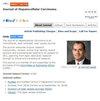IL-6 Released from Hepatic Stellate Cells Promotes Glycolysis and Migration of HCC Through the JAK1/vWF/TGFB1 Axis
IF 4.2
3区 医学
Q2 ONCOLOGY
引用次数: 0
Abstract
Purpose: The crosstalk between hepatocellular carcinoma (HCC) cells and hepatic stellate cells (HSCs) is one of the important mechanisms of liver cancer metastasis. The relationship between liver cancer metastasis and glycolysis has been extensively studied recently. However, the role of von Willebrand factor (vWF) mediated glycolysis mechanism in liver cancer metastasis is currently unknown.Methods: Western blot was used to verify the expression of vWF in HCC cells. PAS staining, glycogen and L-lactate content assays were used to reflect cellular glycolysis levels. The ability of cell migration was explored by Wound-healing and Transwell assays. Besides, the effect of vWF on the progression of HCC in vivo was also studied using subcutaneous xenograft model.
Results: vWF derived from HCC cells promoted tumor migration by mediating glycolysis. Besides, vWF participated in the crosstalk between HCC cells and HSCs. HCC cells activated HSCs through vWF-mediated TGFB1 expression and secretion, and activated HSCs upregulated vWF expression in HCC cells through IL-6 secretion feedback. Further, in vitro and in vivo experiments also confirmed the importance of the JAK1/vWF/TGFB1 axis in regulating HSCs-derived IL-6 mediated HCC migration and growth.
Conclusion: In summary, this article demonstrated that IL-6 released from hepatic stellate cells enhanced glycolysis and migration ability of liver cancer cells by activating JAK1/vWF/TGFB1 axis which may also be a potential target for inhibiting liver cancer metastasis.
Keywords: glycolysis, crosstalk, vWF, migration
肝星状细胞释放的 IL-6 通过 JAK1/vWF/TGFB1 轴促进糖酵解和 HCC 迁移
目的:肝细胞癌(HCC)细胞与肝星状细胞(HSCs)之间的串联是肝癌转移的重要机制之一。肝癌转移与糖酵解之间的关系近来已得到广泛研究。然而,von Willebrand因子(vWF)介导的糖酵解机制在肝癌转移中的作用目前尚不清楚:方法:采用 Western 印迹法检测 HCC 细胞中 vWF 的表达。方法:用 Western blot 验证 HCC 细胞中 vWF 的表达,用 PAS 染色、糖原和 L-乳酸含量测定反映细胞的糖酵解水平。通过伤口愈合和 Transwell 试验检测细胞迁移能力。此外,还利用皮下异种移植模型研究了 vWF 对 HCC 在体内进展的影响。此外,vWF 还参与了 HCC 细胞与造血干细胞之间的串联。HCC细胞通过vWF介导的TGFB1表达和分泌激活造血干细胞,激活的造血干细胞通过IL-6分泌反馈上调HCC细胞中vWF的表达。此外,体外和体内实验也证实了JAK1/vWF/TGFB1轴在调节造血干细胞衍生的IL-6介导的HCC迁移和生长中的重要性:综上所述,本文证明了肝星状细胞释放的IL-6通过激活JAK1/vWF/TGFB1轴增强了肝癌细胞的糖酵解和迁移能力,这也可能是抑制肝癌转移的潜在靶点。
本文章由计算机程序翻译,如有差异,请以英文原文为准。
求助全文
约1分钟内获得全文
求助全文

 求助内容:
求助内容: 应助结果提醒方式:
应助结果提醒方式:


